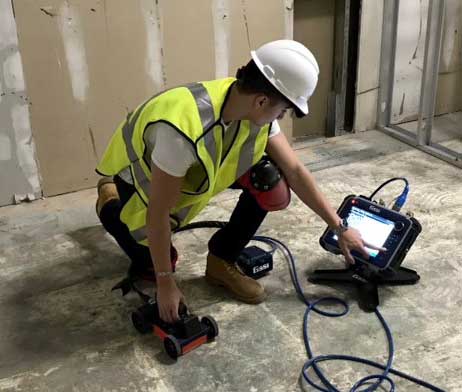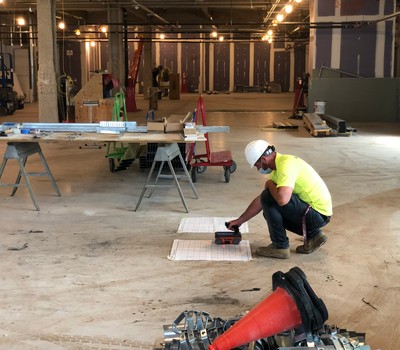Discovering the Depths: A Comprehensive Guide to Concrete Scanning and Its Diverse Applications
In the world of building and facilities development, the meticulous procedure of concrete scanning holds a crucial function in guaranteeing the structural honesty and safety of jobs. As technology remains to evolve, the applications of concrete scanning have actually expanded much beyond mere surface-level analyses. From finding rebar and post-tension cable televisions to mapping out channels and spaces hidden within concrete frameworks, the capabilities of contemporary scanning strategies are both outstanding and vital. Nonetheless, real deepness of concrete scanning's possible reaches even additionally, branching right into unforeseen fields and sparking ingenious options. The interconnected web of opportunities that concrete scanning offers is not only fascinating yet likewise crucial for the development of numerous industries.
Value of Concrete Scanning
Understanding the significance of concrete scanning is important in making sure the safety and stability of frameworks throughout construction and restoration projects. Concrete scanning makes use of innovative technologies such as ground-penetrating radar (GPR) and electro-magnetic induction to find embedded items, spaces, or various other abnormalities within concrete frameworks - RainierGPR Concrete Scanning. By carrying out detailed scans before drilling, reducing, or coring right into concrete, building and construction groups can stay clear of unintended damages to crucial architectural components like rebar, avenues, or post-tension cords. This positive approach not only avoids expensive repair work and task delays but likewise enhances overall building and construction safety by mitigating the risk of architectural failures or collapses due to compromised honesty.
Furthermore, concrete scanning plays a crucial role in making certain compliance with building ordinance and policies that mandate the security of existing structural parts during building tasks. By properly mapping out the interior composition of concrete, scanning modern technologies allow construction experts to make enlightened choices that support the architectural stability and toughness of buildings and infrastructure tasks. Essentially, the value of concrete scanning exists in its capacity to secure both the architectural integrity and the workers associated with building endeavors.
Technologies Utilized in Concrete Scanning
Concrete scanning relies on advanced technologies such as ground-penetrating radar (GPR) and electromagnetic induction to precisely spot embedded items and abnormalities within concrete structures. Ground-penetrating radar runs by discharging high-frequency electromagnetic waves right into the concrete.
Electromagnetic induction, on the other hand, functions by generating electromagnetic areas around a concrete framework with a transmitter coil. When metal items exist within the concrete, they disrupt these magnetic fields, triggering eddy currents to flow via the metal. By measuring the modifications in the electro-magnetic areas with a receiver coil, the system can identify the area of metal items in the concrete.
These innovative innovations play a crucial function in non-destructive testing, making certain the safety and security and stability of concrete frameworks in numerous markets.
Applications in Construction Market
Within the building and construction industry, concrete scanning innovation finds varied applications that improve task efficiency and safety and security. One crucial application is the detection of rebar, post-tension wires, and other embedded items before boring or cutting right into concrete structures. By properly mapping out these aspects, building teams can stay clear of expensive problems, make sure architectural integrity, and stop possible safety hazards. Look At This Furthermore, concrete scanning is utilized for finding spaces, such as air pockets or locations of damage within concrete, which can jeopardize the total strength of a structure. By determining these gaps early on, building experts can take needed actions to resolve them and keep the sturdiness of the structure. Concrete scanning plays a crucial role in top quality control by confirming the density of concrete covers over support, making certain conformity with design requirements and criteria. Overall, the applications of have a peek at these guys concrete scanning in the construction sector contribute dramatically to enhancing task operations, reducing threats, and delivering premium results.

Safety And Security Benefits of Concrete Scanning
In the realm of building safety and security, the implementation of concrete scanning innovation offers a vital benefit in preemptively identifying prospective threats and fortifying structural honesty. By making use of advanced scanning approaches such as ground-penetrating radar (GPR) and electro-magnetic induction, building and construction teams can properly find rebar, post-tension cables, channels, and various other concealed objects within concrete frameworks. This aggressive strategy considerably minimizes the risk of accidental strikes throughout drilling, cutting, or coring activities, thereby stopping pricey damages, injuries, and task hold-ups.
In addition, concrete scanning enhances employee safety by supplying real-time details concerning the structural condition of concrete elements. This data enables construction professionals to evaluate the honesty of existing frameworks, recognize deterioration or problems, and make notified choices pertaining to fixing and upkeep procedures. By dealing with prospective safety problems immediately, concrete scanning adds to creating a safe and secure functioning environment and mitigating the likelihood of architectural failings or crashes on construction websites. Ultimately, the safety advantages of concrete scanning not only secure properties and lives however additionally support industry criteria for Click This Link high quality and reliability.
Future Trends in Concrete Scanning
Arising advancements in scanning innovation are poised to transform the field of concrete examination and evaluation. By using the power of AI, these systems can assess huge quantities of information collected throughout scanning procedures to supply even more exact and detailed insights into the condition of concrete structures.
Another significant fad is the growth of even more straightforward and portable scanning gadgets. Miniaturization of scanning tools enables simpler access to confined areas and remote locations, making evaluations more detailed and reliable. In addition, innovations in cordless interaction modern technologies enable real-time data transfer and analysis, promoting quicker decision-making procedures.
Moreover, there is a growing focus on sustainability in concrete scanning technologies - RainierGPR Concrete Scanning. Makers are increasingly incorporating environmentally friendly products and energy-efficient functions right into their tools to decrease ecological effect. These future trends are readied to boost the performance, precision, and sustainability of concrete scanning practices, forming the sector's future landscape
Verdict
To conclude, concrete scanning plays an important role in the building and construction industry by guaranteeing the safety and security and efficiency of various projects. By utilizing innovative innovations, such as GPR and radar imaging, specialists are able to properly detect possible hazards within concrete frameworks. The applications of concrete scanning are substantial and remain to develop, making it an important device for keeping the integrity of buildings and framework. As technology advances, the future of concrete scanning holds encouraging developments for improving building and construction processes.
